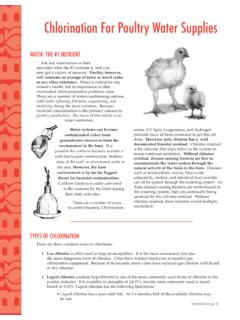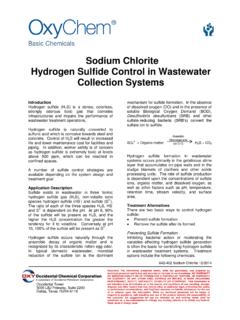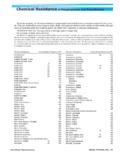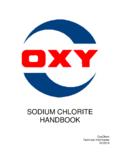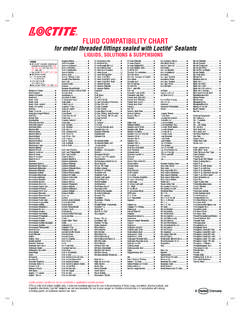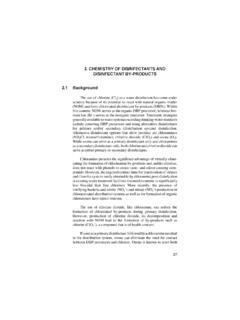Transcription of Shock Chlorination For Private Well Owners
1 Shock Chlorination For Private well Owners Shock Chlorination . Shock Chlorination / well sanitation is simply the process of adding a sanitizer to the well in high concentrations to destroy any bacterial growth. Shock Chlorination is effective in reducing an iron bacteria, hydrogen sulfur, or coliform bacteria problem. However in severe cases, it may be only a temporary solution, and must be repeated periodically. There are a number of reasons to Shock chlorinate a well . 1. Your well has tested positive for coliform bacteria. 2. Iron bacteria has plugged up pumps, pipes or water conditioning equipment. 3. Flooding, spring runoff, or other natural events could have caused contamination. 4. Smelly water caused by hydrogen sulfide is present in your water.
2 5. General well maintenance. Anytime a well cap is removed the well should be sanitized before it is put back in service. Some states require this. Shock treating a well can be as simple as pouring liquid bleach down the well shaft. Often times this is ineffective as many other factors have a bearing on effective Shock Chlorination , such as: Household bleach is unstable; it may not have enough active chlorine to properly sanitize a well . Built up bio-film from various nuisance bacteria ( , iron bacteria) act as a shield to prevent chlorine from reaching active bacteria colonies. Liquid bleach sometimes does not reach to the bottom of the well , where bacteria can grow. Shock treating a well with already high pH water may not be successful because chlorine is less effective as a sanitizer in high pH conditions.
3 Calcium hypochlorite is the most practical product for sanitizing a well : Highly concentrated (65-73% chlorine ). The higher the percent chlorine, the lower the percentage of inert ingredients. Available in pellet form (sinks to the bottom of well , and slow dissolving) or granular form (fast dissolving). More effective in the presence of organic matter.*. Longer shelf life. When repeated Shock Chlorination does not provide satisfactory results, continuous Chlorination may be necessary. A dry pellet chlorinator, which uses the well as a retention tank, accomplishes * " Chlorination of drinking water has key role in disease control" David V. Rives, Turkey World, June-July, 1993. EFFECTS OF PH ON well SANITATION. When chlorine is dissolved in water, it produces hypochlorous acid (HOCl) and hypo chlorite ions (OCl-).
4 HOCl is the most effective form of chlorine for sanitizing. It is 80 times more effective then OCl-. Figure 1 shows that at lower pH, the maximum amount of HOCl is produced. One of the most limiting factors of well sanitation is the pH of the water. At a pH of 5. to 7, chlorine is predominantly sanitizer and is most effective. By the time pH rises to 9, it has converted predominantly to oxidizer and will not kill bacteria effectively. See chart on the right. Water that has a high pH will render the chlorine in-effective. Adding more chlorine may worsen the problem as it makes the water more alkaline and the chlorine acts as a oxidizer rather then a sanitizer. The pH must be lowered by adding acid to the well water. No matter how effective the Shock Chlorination , it does not take the place of a If water has a high pH, it will have to be safely constructed well .
5 If the well lowered to 6 - to ensure effective Shock immediately becomes re-contaminated, sources Chlorination . This can be done with acid, such of the contamination should be located. as muratic or phosphoric, or dry acids like Obvious sources of contamination may include: sulfamic or sodium bisulfate. Never mix acid Loose well caps or seals and chlorine directly. Add acid to the well water, check pH, and then add chlorine. Flooded well pits Testing of the pH is the only way to verify the Uncased wells effectiveness of any of these acids because of Feedlots draining into wells the variabilities in well water. Inexpensive test kits are available at swimming pool stores or Septic systems drain fields. most places where chlorine is sold.
6 Nearby abandoned wells. Caution must be taken that the pH does not A certified well driller can aid in identifying go below 4; at this point, chlorine dissolved in these problems as well as solving them. the well water will turn into chlorine gas, which can be dangerous in high concentration. 2. INSTRUCTIONS FOR well SANITIZER. Pelleted or granular chlorine can be used in Shock treatment. Pellets sink to the bottom of the well and dissolve slowly. Granular chlorine sinks at a much slower rate and dissolves quickly. 1. Check the pH of the well water. The ideal pH for Shock Chlorination is 6-7. If necessary, pre-treat the well water with an acid before Shock chlorinating (refer to previous page, "effects of pH"). 2. If using pellets, it is very important that when pellets are dropped into the well , cistern, etc.
7 , that the pellets get to the water and not lodged on wiring, pitless adaptor, etc. Make sure that the pellets can be heard hitting the water. 3. Determine the amount of water to be sanitized (refer to tables 1 and 2 below). 4. Refer to the tables to determine the amount of pellets needed. Drop 1/2 of the pellets into the well . Dissolve the remaining pellets in a few gallons of water and pour into the well . 5. To mix the concentration in the well , run water from a hydrant or faucet (plumbed to the well ) into the well for about 15 minutes. This re-circulates the well water, and after a short period of time there will be a strong chlorine odor. Turn off the water. 6. Run water through all taps, spigots, etc., connected to the water system until the smell of chlorine is present.
8 Allow treated water to stand 12-24 hours. After this time, flush all taps. 7. After the system has become completely flushed with clean water, a bacteria check should be done. (Continued on pg. 4). Tables 1 & 2. Chlorine pellets needed for Shock Chlorination . Figures below represent approximate dosage of 100 ppm chlorine. Consult with local or state government to check local requirements. If using granular chlorine, increase amount needed by 20%. Table 1. 2 - 10" diameter wells Table 2. 1 - 5 ft diameter wells well # pellets/ cups pellets/ well # pellets/ Cups pellets/. Diameter(in) 100 ft water 100 ft water Diameter(ft) 100 ft water 100 ft water 2 9 1 328 1 & 1/2. 3 20 2 1316 5 & 3/4. 4 36 3 2960 13. 5 57 1/4 4 5264 23. 6 82 1/3 5 8322 37.
9 8 146 2/3. 10 228 1. 3. CAUTION: On severely contaminated wells, Shock Chlorination may loosen up iron and manganese deposits, algae, or other contaminates to the point that pumps, plumbing and filters may become clogged. Physical cleaning may be necessary. Normal Shock Chlorination will cause discoloration of water. Shock Chlorination does not permanently disinfect a well that has an on-going contamination problem. Continuous sanitation is necessary. Most water treatment equipment (softeners, filters,) should also be Shock chlorinated. Check the manufacturers operating instructions to prevent damage. Do not Shock chlorinate carbon or charcoal filters. Remove or bypass if possible. NOTE: 1 chlorine pellet = 1 gram*. 28 pellets = 1 ounce*.
10 1 cup pellets = 1/2 lb.*. 454 pellets = 1 pound*. (*Approximate). B&B well Sanitizer is made from NSF approved, EPA registered calcium hypochlorite, 73% available chlorine. well sanitizer has a shelf life of 1 year. Albert City, Iowa 800-331-4808. Greensboro, North Carolina 800-645-0081. 4 Chlorination
